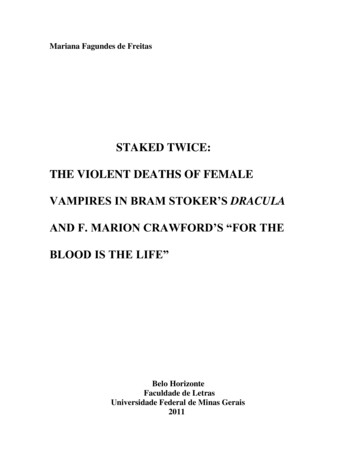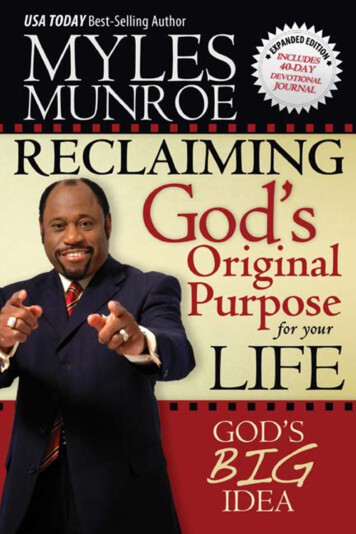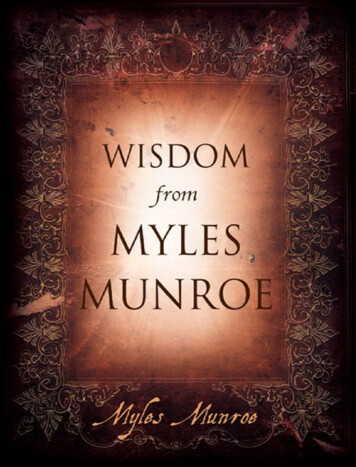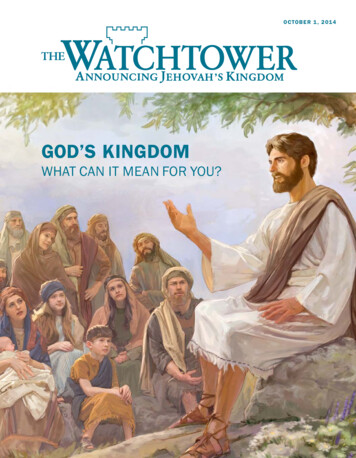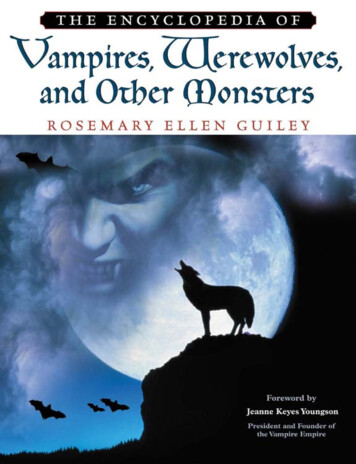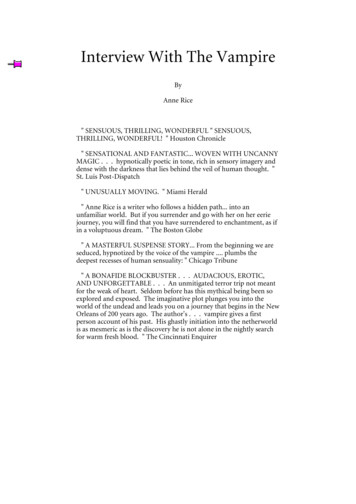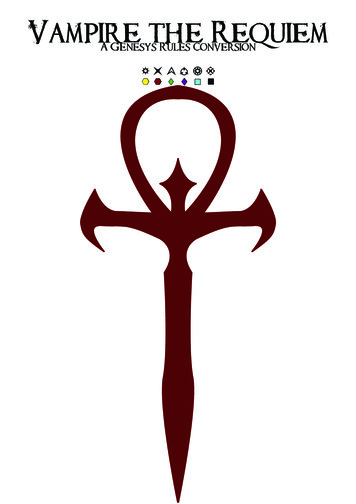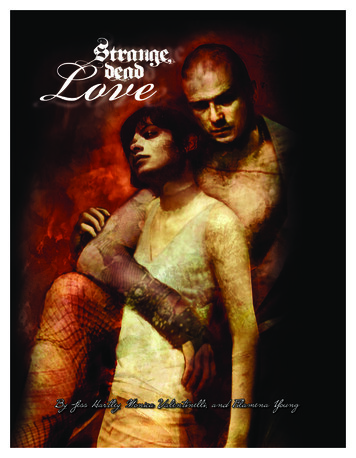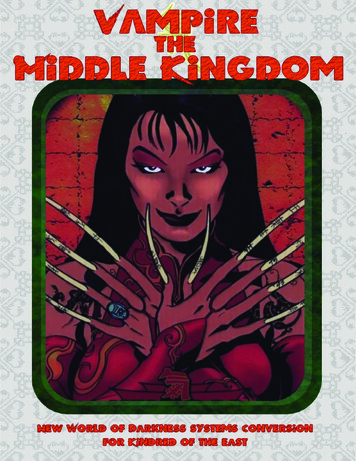
Transcription
Vampire: the Middle KingdomThe Kindred of the EastNew World of Darkness Systems ConversionWritten by Steven Markley (aka I Hate All Life/Predaphile)E-mail: Predaphile@hotmail.comKindred of the East Resources: .htmlWhat This IsThis is a conversion of Kindred of the East to the “new” World of Darkness mechanics. Kindred of the East was, andstill is, a great game, but one hampered by clunky rules and a poorly organized book. Hopefully this version redresses the mechanicalissues while preserving the soul of that wonderful game.Vampire: the Middle Kingdom is largely lacking in background and flavor text, and there's no artwork. (But at least there'sa character sheet!) This is pretty much all crunch; you can get the story elements and descriptions from the Kindred of the East"core," and you'll need that plus the World of Darkness to use these rules. Even so, it's not the simple little rules patch I thought itwas going to be, as bare-bones and no frills as it is. Some things I've had to straight-up rewrite or revise. I attempted to translate theoriginal as closely as possible, but some things have been judgment calls – like clarifying, expanding and/or restricting certainDiscipline arts, revising guanxi, and greatly reducing the utterly ridiculous amount of aggravated damage in the setting. Still, thebasics remain intact, and you'll have no problem recognizing Kindred of the East in its new format.What This Ain'tBefore I start getting e-mails about how “imbalanced” all this is, I'm not converting Kuei-jin to be used in the new World ofDarkness setting, nor is this a re-envisioning of Asian vampires. Instead, I'm using the new system to model the classic Wan Kuei inthe Middle Kingdom setting. The Cathayan vampires presented here aren't compatible with, or balanced in regard to, Vampire: theRequiem's knockoff brand of Kindred, or with any other creatures in the new World of Darkness. This is quite deliberate, as it's mystated intention to model Kindred of the East in its own context, but with the better system. Of course, feel free borrow as much ofthis as you like if you should want to port Cathayan-like creatures to the new setting. Just know that's not what I'm doing with this.And this isn't the final product. I've taken pains to edit this and catch all my mistakes and bugs, but no doubt some will slippast me and the editors. It's an unavoidable part of the creative process. Now-unseen errors will become apparent once this documentis in general circulation. So if you see any problems – typos, wonky or broken mechanics, inconsistencies, missing information,conceptual issues – do me a big favor and drop me a line, will ya? Criticism might be a bit hard on the ego at times, but it's alsoinvaluable. Vampire: the Middle Kingdom will improve through revision, and I need you guys' feedback.Where Are The Heretics and Akuma and Other Disciplines and [Whatever]?A lot of stuff came out for Kindred of the East line, and I simply can't cover all of it. This writeup is pretty massive as it is.I stuck with converting the “corebook” and didn't deviate from that much – I included Iron Mountain as one of the “base” Demon Artsand referenced other Year of the Lotus books for the shen conversions, and that's about it. I'm not ruling out my doing asupplemental document that covers some of this other stuff one day, but for now you can use this foundation to do the conversionsyourself. I'll be happy to help, just get in touch with me.Nitpicks SemanticsThough a great game, several decisive mistakes were made with Kindred of the East from the very beginning. It wasmarketed as Vampire: the Masquerade supplement, in hindsight a bad idea. A supplement to a game line should be thematicallyand systematically compatible with the core game, and Kindred of the East was neither. It should have marketed as its own separateline, with its own complete core rules set and minimal reference to Masquerade. And finally, to nail the game on a semantics point,"Kindred of the East" is itself a misnomer, as the featured vampires aren't Kindred.Honorable Mentions and Mad PropsVampire: the Middle Kingdom wouldn't have been possible without the folks at www.Shadownessence.com, whoprovided invaluable feedback and inspiration for this. It's the best place anywhere on the 'net for World of Darkness fans, so pleasestop by and visit us there, especially the Middle Kingdom forum.Thank you to everyone that pointed out mistakes and typos in the first version of this document, and offered responses to it.Chris Leland (Mr. Gone) was an entirely unintentional omission from the first printing, who helped immensely with formatting this,as well as making the character sheet; thug love and hugs, man. Thanks to LostSoul from SnE for the Kindred of the East symbolartwork. Finally, thank you White Wolf publishing for Kindred of the East and all the other wonderful games you've given us. Thiswork is a labor of love and a supplement to that company's body of work, not a challenge to copyrights or anything like that.
Table of ContentsCharacter 3Dramatic Systems24The Tapestry31Artifacts37The Ten Thousand Things38Character Sheet51
Character CreationUse the rules from the World of Darkness corebook to create characters, except where noted as follows.Archetypes: This game uses Nature and Demeanor, rather than the Virtues and Vices described in the new World ofDarkness core. Choose Archetypes for characters from among those presented in the plethora of original World of Darkness books.(I'm sure you have some of those laying around, so no need for me to reprint the Archetypes here.) Willpower is regained by acting inaccord with one's Nature.P'o Archetype: Choose a P'o Archetype from the list in Kindred of the East, pgs. 92-93.Direction: From pgs. 81-83 of Kindred of the East, choose a Direction for your character.Attributes: The Attributes used are those defined in the World of Darkness corebook, but the player gains the “classic” 7/5/3dot spread to distribute among the three categories (in addition to the free dot in each Attribute). The sum of Resolve and Composurecan be no less than five dots (as Willpower for starting Cathayans must be at least 5).Skills: Use the Skills from World of Darkness, though characters receive a 13/9/5 spread; no more than three dots may beassigned to any Skill during this time. Characters receive three Specialties. The Martial Arts Skill is now covered by Fighting Style:Kung Fu, Brawling Dodge and other Physical Merits. Torture is an Intimidation Specialty, and Enigmas falls under Investigation.Linguistics is covered by the Languages Merit. Portents and the Rituals are Occult Specialties (rites themselves are covered by theRituals Merit). Meditation is handled through [Composure Wits], as described on pg. 51 of World of Darkness. Finally, a Kueijin's Empathy rating can never exceed his Hun.Experienced players and Storytellers may be well beyond needing the books to hold their hands and tell them how todistribute their dots; it's not like real people are built according to the Primary/Secondary/Tertiary setup, after all. Some Storytellersmight want to give players discretionary pools of 15 Attribute dots and 27 Skill dots (or however many dots they feel is appropriate),and let them distribute as they like – though of course, giving submitted characters a once-over is a good idea. Some narrators mightwant to set limits so that all the dots aren't dumped into one category, but such lopsided characters tend to “balance” themselves bybeing unable to function outside combat or whatever their focus is.Virtues: Characters have four dots to allocate to Chi Virtues; each Chi Virtue has a free dot. P'o starts at 3, and Hun at 1.Players can spend Merit Points to improve their Virtues, but do mind the paired Virtue ratings limitation on the Dharma chart (pg. 8 ofthis document). Chi Virtue rating determine the character's Balance. Information on the Virtues is scattered about Kindred of theEast in typical haphazard fashion; your first test, Grasshopper, is diving in and sorting it all out. Also, see pgs. 6-8 of this document forthe descriptions of the Virtues, information on Balance, Demon Chi rules and the like.Dharma: Dharma serves as a vampire's guide for morality, behavior and fundamental philosophical outlook, and measuresher understanding of her role under Heaven. See pgs. 63-73 of Kindred of the East for information on the Dharmas. (The Moralitytrait doesn't apply to Wan Kuei, an aspect of the new World of Darkness setting rather than something central to the system itself).The systems information for Dharmic advancement and associated capabilities can be found on pg. 9 of this document.Disciplines: Starting vampire characters have three dots to allocate between Disciplines, though at least one must be aDemon Art. See pgs. 10-23 of this document for systems conversions of the Disciplines.Merit Points: Kuei-jin have 20 Merit points. (This may seem high, and by new World of Darkness standards it is. However,Merit Points cover what Background points and freebie points used to, so this amount makes starting Cathayans about equal to whatthey are in the original game.) Vampires have access to all the Merits in the World of Darkness core except Unseen Sense, and canpurchase the following Merits (described below): Herd, Horoscope, Jade Talisman, Magic Artifact, Nushi and Ritual. In addition,Merits from the original World of Darkness that would apply to Cathayans may be purchased at the costs listed in those books, thoughwill have to be converted to the new rules on a case-by-case basis. Finally, Merit Points may be used to buy extra trait dots (in themanner freebie points used to; see below).Flaws: Flaws taken at character creation offer bonus exp when they come into play, as per new World of Darkness rules.(Option: There's no reason a Storyteller can't do Flaws the old way instead, and have them offer additional Merit dots. However, theStoryteller should choose one approach or the other, and not both.) Choose and convert appropriate Flaws from the old books.Guanxi: This optional system is described on pg. 30 of this document.Merit Point CostsExperience Point CostsAttribute: 5 per dotSkill/Specialty: 3 per dot.Merit: listed costChi Virtue/Hun: 3 per dot.P'o: 1 per dotDiscipline: 10 per dotRite: 1 per levelDharma level: 10 (ST's option)Attribute: new rating x 5Skill: new rating x 3Specialty: 3Merit: new rating x 2Chi Virtue/Hun: new rating x3.P'o: new rating x 1Discipline: new rating x 8Rite: level x 1
MeritsThe Merits listed here are exclusive to Kuei-jin and may not be taken by mortals or other characters. Merits from the Worldof Darkness book that are especially appropriate for Kuei-jin include Fighting Style: Kung Fu, Holistic Awareness, Iron Stamina,Language, Meditative Mind and Mentor. Banned are Quick Healer (vampires must spend Chi to heal), Status among Wan Kuei(covered by Dharma), Unseen Sense, and Strong Lungs (undead don't breathe). Iron Stomach, Natural Immunity and Toxin Resistanceare perhaps redundant for undead, but can reflect an additional degree of resilience above and beyond that of other vampires.HerdThe Ten Thousand Demons typically build groups of mortals from whom they can feed reliably, providing a stable source ofChi and making hunting easier. Not only is this convenient, it's a near-vital survival tactic for any vampire of advanced age. A herdmay take many forms, from circles of clubgoers to a Scarlet Screen formed of loyal family, from exclusive brothels to actual cults builtaround the Hungry Demon as a god-figure. though due to the practices of certain heretics and the dangers of hubris to Dharmicadvancement, the last is usually frowned upon by many vampires, including elders. A herd may come in handy for other purposes thanproviding Chi, although its members typically aren't too loyal or competent (for more effective pawns, purchase Allies or Retainers).Herd is often added to characters' rolls for hunting; see pg. 24 of this document for hunting rules.1111111111111111-3 vessels4-6 vessels7-12 vessels13-24 vessels24-48 vesselsHoroscopeHoroscope functions much like the Background of the same name in Kindred of the East (pg. 86) except as noted here, andmay only be rolled once per story. A success on a Horoscope roll adds three dice to a roll, though no more than three dice may be addedto any single roll, and Horoscope dice apply to successive rolls in the order they're rolled. For example, if two successes are attained ona Horoscope roll, the character gains three bonus dice on the next two rolls. This doesn't stack with bonus dice from Willpowerexpenditure. The actions taken should be at least ostensibly in the interest of furthering the vampire's Dharma, fulfilling a Directionduty or otherwise appropriate; Heaven won't smile on overtly destructive, pointless or selfish behavior.This Merit may only be purchased at character creation, and can't be purchased or increased with experience.Jade TalismanThe Jade Talisman Merit functions exactly as the Background described in Kindred of the East (pgs. 86-87).Magic ArtifactThe Magic Artifact Merit functions like the Background described in Kindred of the East (pg. 87). Choose from the sampleartifacts listed on pgs. 37 of this document; the Merit cost is equal to the level of the artifact.NushiMany wu patronize a Nushi spirit, which grant their supplicants benefits and a little prestige among Kuei-jin with a respectfor tradition (though the latter isn't a given, especially if the spirit in question is of poor repute or contemporary nature). The NushiMerit is a group Merit, not something that applies to only one character: Nushi is purchased with Merit dots at character generation,with each player contributing Merit dots toward its purchase. Thereafter, players spend experience points to boost the power of theirnushi; as the nushi grows in power and stature, so too does its wu. See pgs. 32-37 of this document for information and systems fornushi and other spirits, including how to improve patron spirits with exp.RitualsThis Merit is rated from one to five dots, and increased through exp. The character can learn and perform any rite of a ratingequal to or lower than her Rituals rating. The character gains her starting Rituals rating as levels of rites (so an initial rating of 2 inRituals means the character has two levels of rites: either two one-dot rites, or one two-dot rite). After this, individual rites must bepurchased separately, at a cost of [level x 1] exp – the Rituals Merit simply provides the potential to learn rites of certain levels, andgaining Rituals dots doesn't automatically bestow knowledge of any new rites. Rites are given abbreviated conversions on pg. 23 ofthis document; for the rites' descriptions, see pg. 126-131 of Kindred of the East.
VirtuesChi VirtuesA Cathayan's Virtue ratings signify his temperament and personality, and determine the nature of his weakness. They don'tserve the role of Nature, but have bearing on how that Nature manifests; examples are given below. Rather than being a determiner ofbehavior, Chi Virtues both reflect and inform it; a passionate and impulsive mortal that rises as a Kuei-jin will be Yang-Balanced. If helearns restraint and detachment as he progresses in unlife, this change is represented by an increase in Yin. (For rules on staking, seepg. 28 of this document.)Yin-Balanced: A character with a Yin rating two or more dots higher than his Yang is Yin-Balanced. Such vampires tend tobe calm, introverted and dispassionate. They also appear a little paler than is healthy, and are cool to the touch. A Yin-Balanced Bravomight be a methodical torturer, while a character with the Director Nature and strong Yin is likely a plotting bureaucrat. Yin-BalancedWan Kuei, like Kindred, are staked by wood (a Yang element).Yang-Balanced: A Hungry Demon with a Yang rating two or more dots higher than his Yin is Yang-Balanced. Those withpronounced Yang are passionate, and often impulsive and expressive; many channel this energy into physical and social aggression. Ofall undead, Kuei-jin attuned to Yang appear the most vital and lifelike (often too much so), and their skin feels almost as warm as amortal's. A Yang-Balanced Hungry Demon with the Bravo Nature would probably be a violent bully, while his Director counterpartwould likely excel as a fiery orator or charismatic leader. As metal is attuned to Yin, a sharp metal instrument may be used to stakeYang-attuned vampires.Balanced: A vampire with equal ratings in Yin and Yang, or with Chi Virtue ratings within one dot of one another, isBalanced. Neither the fires of Yang nor the ice of Yin drive his behavior. However, many Balanced vampires (especially those new tothe undead condition) find lack of focus in this equilibrium, and haven't a strong rating in either Chi Virtue. A Balanced Bravo ischaracterized neither by rash anger or clinical cruelty, but perhaps straightforward sadism; a Director with a Balanced perspective iswell-suited to diplomacy, a Court official's representative or management, but may lack the strength of personality to connive orpersuade his way into a position of great power. Balanced Demons are immune to being staked, but suffer temporary imbalance if theyhave two or more points of one type of Chi than its counterpart.YinYin Chi: The vampire can store a number of Yin Chi equal to his Yin Virtue before becoming imbalanced.Resisting Fire Nature: The roll to avoid Fire Nature is a reflexive [Composure Yin - P'o] roll; success indicates WindNature is retained. See Soul States, pg. 29.Ghostsight: Spending a point of Yin allows a vampire to read mortals' deathmarks for one scene, and thereby estimate howclose to death that person or living creature is (this ability doesn't apply to other vampires, wraiths or other beings that are not trulyalive). Three turns of concentration and a [Wits Occult Yin] - Wall roll allows a character can perceive the Yin world and itsinhabitants (including ghosts) for a number of turns equal to the successes on the roll.Sense Weakness: With three turns of concentration and a [Wits Medicine Yin] roll, a Kuei-jin can sense a livingcreature's physical weaknesses, determine the presence and extent of injury, or detect disease; this can be resisted with [Stamina Composure] if the victim is aware of the attempt. A similar roll is allowed to detect structural flaws and damage in objects; use Craftsin place of Medicine. In either case, a successful roll grants a bonus die when making attack rolls against the subject. Alternately, thisextra die may be applied to [Intelligence Medicine] rolls to treat a mortal's sickness or repair an item. In no case may this ability beused against undead or spirits, though living shen are fair game. This benefit lasts for one scene.Aspecting the Corpse: Kuei-jin animated with Yin Chi are considered “black cycled.” Black-cycled vampires needn't spendany more Chi to animate for ten days, but are pale, corpse-like and unwholesome: they suffer a -1 penalty to all Social and Empathyrolls when dealing with mortals.Yin Imbalance: A vampire with three or more dots in his Yin Virtue than in Yang is imbalanced, and is known as a ch'ingshih. On the plus side, his wound penalties are halved (rounded down), and he takes lethal (rather than aggravated) damage from fire.However, he must spend Yin every night to animate himself (gaining none of the benefits of black cycling), and he can't scarlet cycle.All Hun, P'o and Den rolls suffer a -1 penalty (including most uses of Soul Arts, unlocking Demon Chi, and checks for Wave and FireNature), as the character is “numb”to the urgings of his higher and lower souls, and tends to view auspicious events and moments ofblindness with clinical detachment. Finally, every time a ch'ing shih takes damage from sunlight or backlash from Chi imbalance, theSocial roll penalties inflicted become permanent (maximum -3) as he grows to resemble a rotting, walking corpse.A ch'ing shih restored to balance (through a Yang Virtue increase doesn't instantly regain his normal appearance, but mayheal a lost Social die as if it were three levels of aggravated damage. Each point so restored requires a lunar month. (A vampire thatsuffers a -3 penalty can restore his appearance as if it were nine levels of agg over the course of three months.) Special Yang infusions,alchemic treatments or mystical curative powers may hasten this recovery.
YangYang Chi: The vampire can store a number of Yang Chi equal to his Yang Virtue before becoming imbalanced.Wave Nature: The roll to avoid Wave Nature is a reflexive [Composure Yang - P'o]; success indicates Wind Nature isretained. See Soul States, pg. 29.Lifesight: By concentrating for three turns and making a [Wits Occult Yang] - Wall roll, the Kuei-jin can perceive theYang world and the spirits in the area for a number of turns equal to the successes on the roll. Spending one Yang Chi allows thevampire to attune himself to the ebb and flow of life energies around him for one scene. By rolling [Intelligence Empathy] roll, hecan divine the true feelings two people have for each other or for him, though this roll can only be made upon first meeting between thesubjects that scene. Three turns of concentration and a [Wits Empathy Yang] roll allows a Cathayan to either get a feel for thegeneral emotional ambiance of an area, or “home in” on a mortal evincing a certain emotion (lust, anger, sadness, etc.).Healing: By manipulating a small amount of his Yang-infused blood (one Chi point's worth), the vampire creates a singledose of a foul-tasting but potent elixir that will restore a mortal's health. Each draught restores one Health box of lethal damage or twoboxes of bashing.Aspecting the Corpse: A vampire that animates with Yang Chi is “scarlet cycled.” Yang Chi grants the character asemblance of life (allowing him to function normally in social situations), but burns through the body quickly: it only animates him forone night.Yang Imbalance: A rather common affliction in the Golden Courts, a Cathayan with three or more dots in his Yang Virtuethan in Yin is imbalanced. The vampire can tolerate indirect sunlight exposure for twenty minutes per Stamina dot, and direct sunlightfor five minutes per Stamina dot. However, fire attacks inflict an additional level of damage to him, he's especially prone to catch andtransmit diseases, and is hungry all the time: he is ravenous at five or fewer Yang Chi, and uncontrollable at three or fewer. He alsocan't black cycle, and must spend Yang Chi each night to animate himself. The P'o gains an additional die to incite Fire and WaveNature, and checks must be more made more frequently. He can now impregnate mortals (or be impregnated, if female); follow therules for pregnancy in Kindred of the East, pg. 140Soul VirtuesSoul Virtues influence a Kuei-jin's behavior in a similar manner as Chi Virtues. A character with high Hun acts with clarity,purpose and integrity, while one with a low rating works more on instinct and immediate need than intellect. Don't confuse Hun formorality or honor; it's not uncommon for a Cathayan with a high Hun and low P'o to perform wicked acts with mindful intent. A highP'o, however, mandates some degree of evil and monstrosity, even if it manifests only during Shadow Nature. Most Cathayans areprone to evil urges, greed and cruelty by default, and those with high P'o are even more driven thus; discussing vampires with low P'o isan academic exercise, as no weak Demon could claw its way out of Yomi.HunRetaining Wind Nature: Whenever the vampire's P'o attempts to take control of the character – including when a Demon Artis evoked – the player rolls [Resolve Hun - P'o] to retain his Wind Nature. See Soul States, pg. 29, and also rules for using DemonArts on pg. 13.Tempering the P'o: By rolling Hun alone and attaining one or more successes, the Kuei-jin's higher self remains aware ofwhat the Demon does in his body during Shadow Nature instead of blanking out entirely (but is unable to do much more than observe);this is a reflexive roll. However, spending a Willpower point allows the Hun to thwart actions taken by the P'o very briefly (forexample, dropping a gun, screaming a warning, etc.).Sharpened Senses: By concentrating for a turn, the Wan Kuei may add his Hun Virtue to the next basic perception roll hemakes (though not to any supernatural perceptions, such as Cultivation arts or the Deathsight ability described under the Yin Virtue).Spirit Speech: Assuming the vampire knows a spirit is there (which can be determined through Yangsight or Deathsight), a[Presence Hun] - Wall roll allows him to open a dialog with that spirit for a scene .Empathy: A character's Empathy Skill rating can never exceed his Hun Virtue.Hun Imbalance: A character with a Hun Virtue three or more higher than his P'o is imbalanced; this state is rare among theWan Kuei, as disposed as they are to wickedness. The character can't spend Willpower for extra successes, and can never recover anymore than one Demon Chi upon waking each night.
P'oNature Shift: Whenever a character risks a change in soul states (for example, going into Shadow, Fire or Wave Nature), theP'o Virtue is always applied as a penalty to the roll (possibly in addition to other applicable modifiers).Whenever a Demon Art is invoked, the vampire must check for Shadow Nature. However, the character's rating in thatDemon Art may be added to that roll; such intimate familiarity with the P'o allows the vampire to use it with some less risk.Demon Chi: The vampire can store a number of Demon Chi up to his P'o rating, though can't exceed this.Demon Chi is used to power Demon Arts, but may also be used “raw”. if the vampire can access it. To unlock Demon Chi,the player rolls [Stamina P'o - Hun]. (Note that one needn't unlock Demon Chi spent on Demon Arts, only when using that energy inits raw form.)The character may spend a number of Demon Chi equal to his Stamina per turn. A spent point of Demon Chi may be used forone of the following effects, which takes effect on the turn after the Chi is spent (the player must announce the desired benefits to theStoryteller before the beginning of the next turn, after the Demon Chi is spent). If multiple Demon Chi are spent, the character canbenefit from more than one effect: three Demon Chi can buy (1) six additional attack dice, (2) two extra attack dice, and add P'o toSpeed twice, (3) sprout fangs and a maw and make one extra attack, or any combination the player desires. Add two dice to a single Brawl or Weaponry attack roll; this benefit stacks with itself. Gain an extra attack. Each attack that turn is made at a penalty equal to the total number of attacks made; Defense isretained. (For example, on Turn One the player spends two Demon Chi for extra attacks. On Turn Two, three attacks aremade at -3.) This may be combined with Fighting Style Merits that allow multiple attacks, though attack penalties stack. Add P'o rating to Speed for one turn; this benefit stacks with itself. Sprout fangs that allow blood-drinking, and inflict lethal damage on a Strength Brawl attack (though a grapple must beestablished first). For two Demon Chi, the vampire manifests a gaping maw that adds 1 to the attack roll and requiresno grapple to be used. These dental augmentations last one scene.Upon waking for the night, the player may make a reflexive [Stamina P'o] roll, with each success restoring a point of DemonChi to the character's pool. Demon Chi, once spent, is gone for the reminder of the night. However, the Kuei-jin may further “milk”the Demon for infernal energy in emergencies, though each attempt becomes more difficult and provokes an immediate check for FireNature; both rolls are made at a cumulative -1 penalty.Demon Arts: A vampire may have no more dots in a Demon Art than his P'o rating.Resisting Influence: Any attempt to exert mental or emotional control over a Kuei-jin allows the character to defend with hisP'o as a reflexive action, though he risks falling to Shadow Nature. He may elect to add P'o to his resisted roll (or roll only P'o whennormally no roll is allowed), but must immediately make a roll to avoid Shadow Nature.Provoking Fire Nature: If his player succeeds on a [Resolve P'o - Hun] roll, a vampire can work himself into a frenzy andwillingly enter Fire Nature; this is a reflexive action. See Soul States, pg. 29.P'o Imbalance: A vampire with three or more dots in P'o than Hun is imbalanced. Such a debased vampire is in danger oflosing his Dharma forever, and likely spends much of his time under the control of the Demon. The P'o can force a check for ShadowNature once per night at a time of its choosing, regardless of the Kuei-jin's actions.
DharmaAll Cathayans automatically start out at Dharma 1. After that, Merit points and experience points can't be used to increaseDharma – the opportunity for Dharma gain (and loss) hinges purely on roleplaying, though the dice help resolve those events when itcomes. Vampire characters must seek out and benefit from auspicious events and Moments of Den, and they risk losing everything theyworked toward in Moments of Blindness brought on by poor behavior. Welcome to the mercurial unlife of the Wan Kuei.As an optional rule (read: cleared with the Storyteller), a player may spend 10 Merit Points for her character to start withDharma 2, but no higher than this. This allows experienced characters, as well as a little room for mistakes – a good thing forbeginning players learning the ropes. As it stands now, all it takes is one serious slip for a fresh character to fall to the chi'h-mei state.Moments of Den: When a character is enlightened, and stands on the cusp of greater understanding of h
Character Creation Use the rules from the World of Darkness corebook to create characters, except where noted as follows. Archetypes: This game uses Nature and Demeanor, rather than the Virtues and Vices described in the new World of Darkness core. Choose Archetypes for characters from among those presented in the pleth
